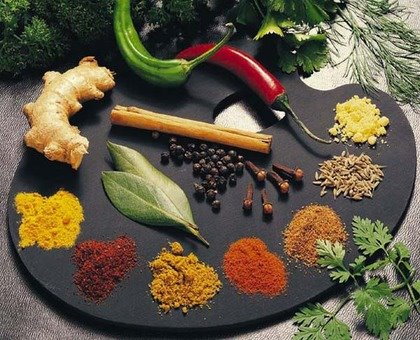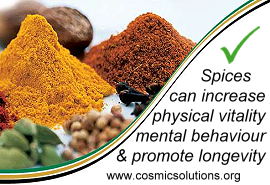Herbs and Spices Healthy Benefits

Usually the leaf of a plant species used in food preparation is quite often referred to as a culinary herb, while any other part of the plant used would be referred to as a spice.
Some examples of the spice class may include: the roots (ginger), the bark (cinnamon), the buds (cloves), the berries (peppercorns), the flower stigma (saffron), the fragrant seeds (cumin). The fragrant seeds are usually collected from the plant when flowering has ceased.
Using the coriander plant as an example, whilst the leaves are certainly referred to as a herb, so are the roots and stem of this plant species because they are quite often used fresh during food preparation. Very much the same as a fennel bulb, or garlic clove would be used fresh. The coriander seeds would be dried prior to use in food preparation, therefore classing them as a spice.
Many ancient records of civilisations past have documented, whether by illustration or written records, the use of herbs and spices for health benefits, medicinal purposes, cooking and flavouring of foods, a form of currency, and even for the use as early preservative measures. It is believed that the Sumerians were using herbs such as thyme for health and medicinal purposes as early as 5000 BC. There is also evidence of Mesopotamian farmers growing garlic as early as 3000 BC. The earliest record of an international trade in herbs and spices dates between 4500-1900 BC, and at that period in time was predominately with Ethiopia.
Cinnamon and Cardamom were in great demand by the ancient Egyptians and regular trade took place with Ethiopia. Garlic cloves and dried mint leaves were common findings in many Egyptian Tombs dating around 1000 BC. Large quantities of onions, garlic, and radishes were fed to their slaves, allegedly to keep them healthy.
The Assyrians of Mesopotamia (now modern day Iran and Iraq) also possessed knowledge about the medicinal and health benefits of herbs and spices, and often referred to the medicinal use of thyme, juniper, and saffron, in writings that were dated around this same time period.
Ancient Rome and Greece indicated the use of herbs more so than spices in their historical written records. Hippocrates had an inventory of 300 herbal preparations that were used for medicinal purposes dating between 460-377 BC, also mentioning the use of rosemary, cinnamon and garlic. Licorice was highly valued for its effectiveness and anti-inflammatory properties when treating asthma, and chest complaints, mint for its successful effects on the digestive system, and rosemary for its noticeable memory improvement qualities.
A Greek physician, surgeon, pharmacologist, and botanist called Pedanius Dioscorides published the first plant thesis around the time period of the first century AD. This plant thesis detailed 600 herb plant species, and instructed on the choosing, storage, and the application of these plant species for health and medicinal purposes. This detailed plant thesis was used as the primary herbal reference in Europe right through until the 17th century.
The Chinese have always traditionally incorporated nutrition and good health. Herbs and spices were specifically added to food preparation for both nourishment and health benefits. Ginkgo biloba and ginseng were traditionally used to improve cognitive performance and stamina, nutmeg for diarrhoea, cinnamon for colds and flu, and galangal for abdominal pain.
Ayurveda is the traditional medicine of India, and is believed to have evolved in the Himalayas about 5000 years ago. It is also believed that medicinal herbal awareness was conveyed verbally until it was finally documented in Sanskrit poetry (the Vedas) around the time period of 1500 BC.
Ayurveda flourished around the 7th century and strongly focused on the promotion of good health and disease prevention, with the emphasis on a healthy wholesome diet. Ginger was considered to be the universal medicine and often used to treat indigestion and nausea, cinnamon was used to stimulate circulation, and basil was utilised for the protection and treatment of heart complaints.
Herb And Spice Consumption
Related To Lower Incidence Of Disease!
Mediterranean diets have long been associated with noticeably decreased instances of certain chronic diseases, such as cancer and heart disease. While Mediterranean dietary studies are complex in their nature, these diets do include substantial amounts of rosemary, thyme, basil, and garlic, amongst many other herbs. These observations in cultures following traditional diets may explain and reinforce the preventative and protective qualities of herbs and spices when incorporated into the diet.
Extensive medical research has found that herbs and spices are rich in phytonutrients. Phytonutrients are spicy plant constituents that have potent anti-cancer, anti-toxin, anti-oxidant, anti-inflammatory, and numerous other health promoting nutrients. Nutrients found in oregano, rosemary, cloves, fenugreek, ginger, turmeric and various other herbs and spices can assist in the prevention of cancer, heart disease, and many other degenerative diseases. Research has also determined that herbs and spices can actively encourage longevity.
Medical researchers are reporting there to be a link between birth date and a predisposition to certain illnesses.
We have been led to believe that the way to better health is more about doctors and medical technology than it is about individual responsibility and personal discipline.
Herbs and Spices can counter the fundamental cause of cancer which is DNA damage - this can occur as a result of aging, genetic susceptibility, and exposure to an assortment of carcinogens.
Herbs and spices are powerful preventative agents against cardiovascular disease, as they modify most risk factors as well as other illnesses and pathological processes associated with this condition.
Site Links
Affiliates
- Deakin Better Health Channel
The Medicinal and Health Benefits - Global Health Information
Promoting Healthier Choices

Herbs & Spices
Anise is a Mediterranean spice that, in the West, is used mainly to flavour confectionery. In its native countries it is an important flavouring for alcoholic drinks like raki, ouzo and pernod. Traditionally it is used to treat coughs. Anise contains limonene which is known to have an inhibitory effect against a number of cancers.
It also contains eugenol which inhibits platelet aggregation. This makes it a valuable spice to take in the prevention of cardiovascular events such as heart attack and stroke."
In addition to their culinary uses, they have mild analgesic properties and oil of clove has long been used in dentistry as a treatment for toothache. Cloves are loaded with many highly effective antioxidants including procyanidin and quercetin that give this spice the distinction of having the highest antioxidant activity of all foods!
There is also evidence that eugenol and acetate inhibit platelet aggregation and thus protect against heart attacks and thrombotic strokes."
Ginger is one of the most popular of all the spices and is derived from the root of a plant indigenous to Asia which is now cultivated across the globe for use in an enormous variety of foods, drinks and traditional medicines. It is used in folk medicine to treat colds and influenza and is an effective anti-emetic used in the treatment of both motion sickness, and the nausea and vomiting associated with pregnancy.
Numerous studies investigating ginger's medicinal properties have also shown it to be effective in the prevention and treatment of many of our more serious chronic degenerative diseases."

